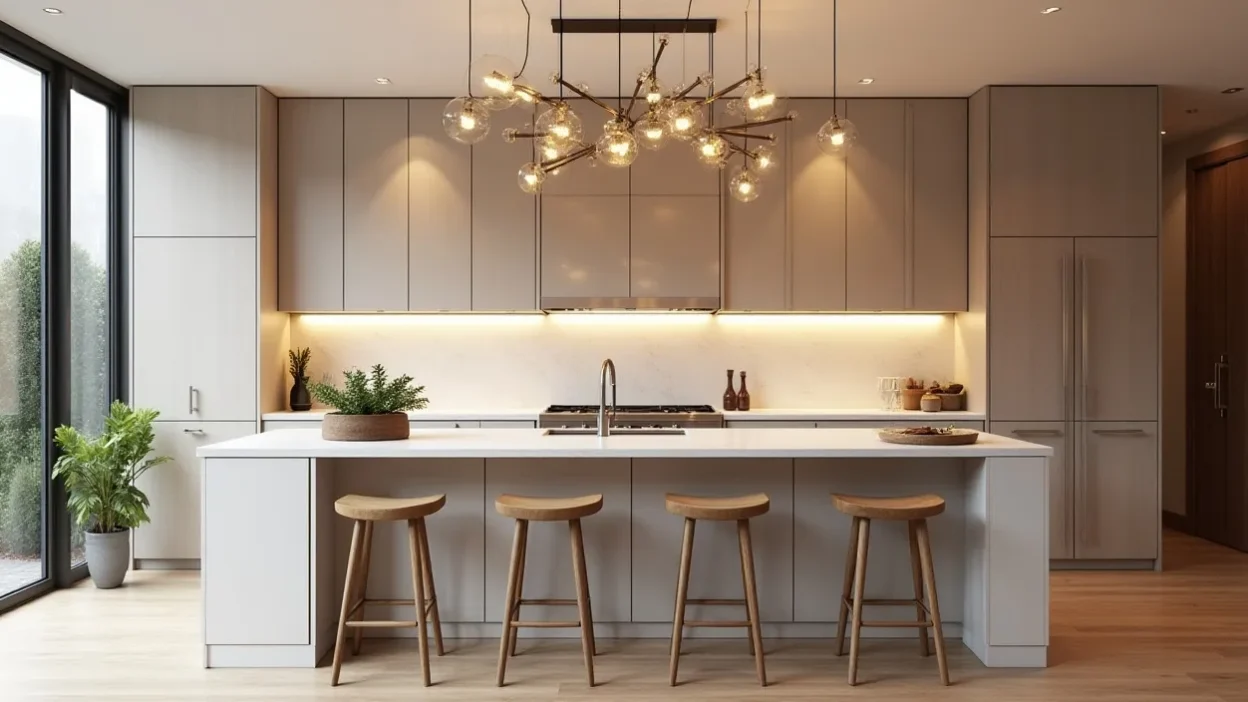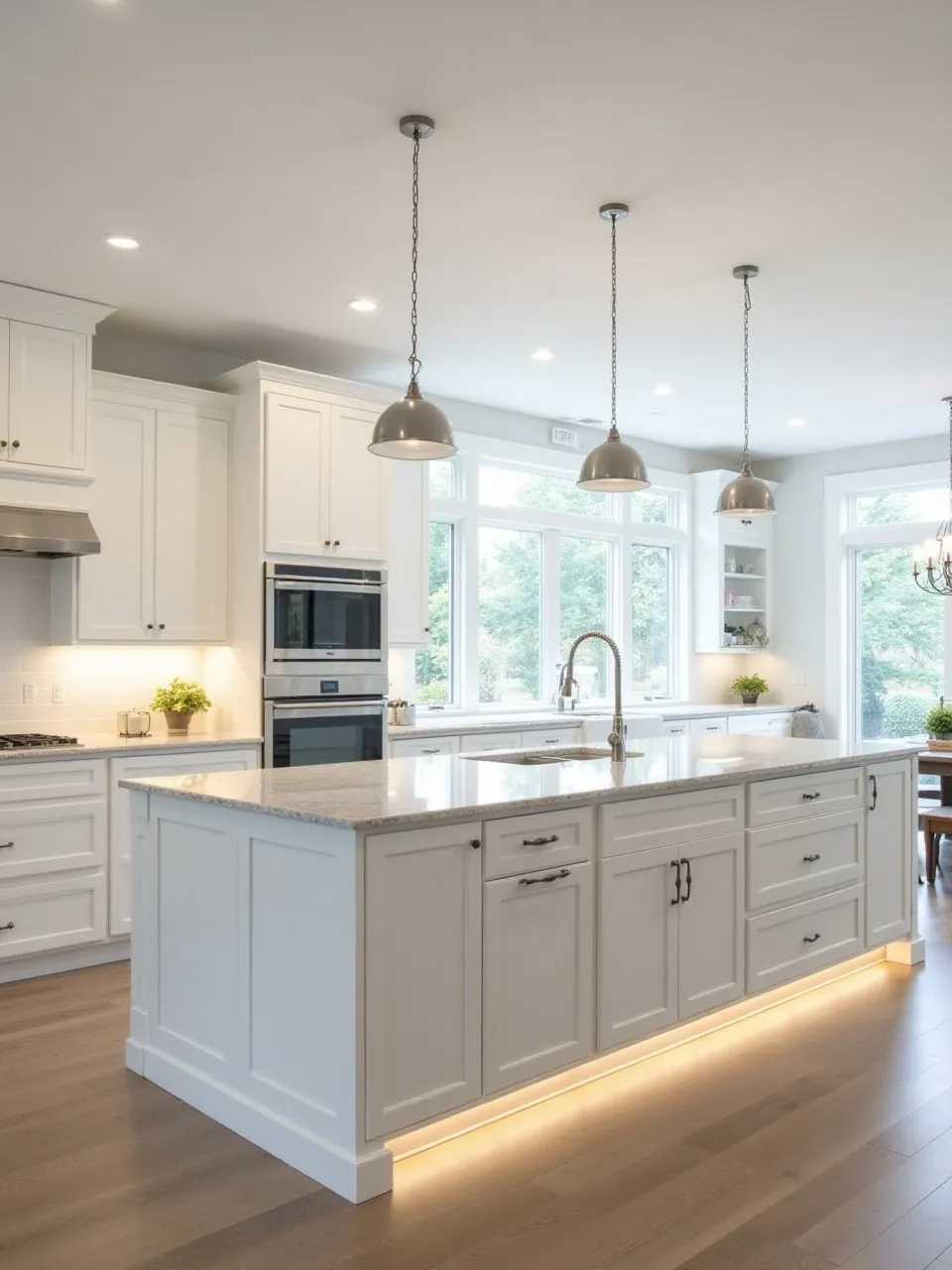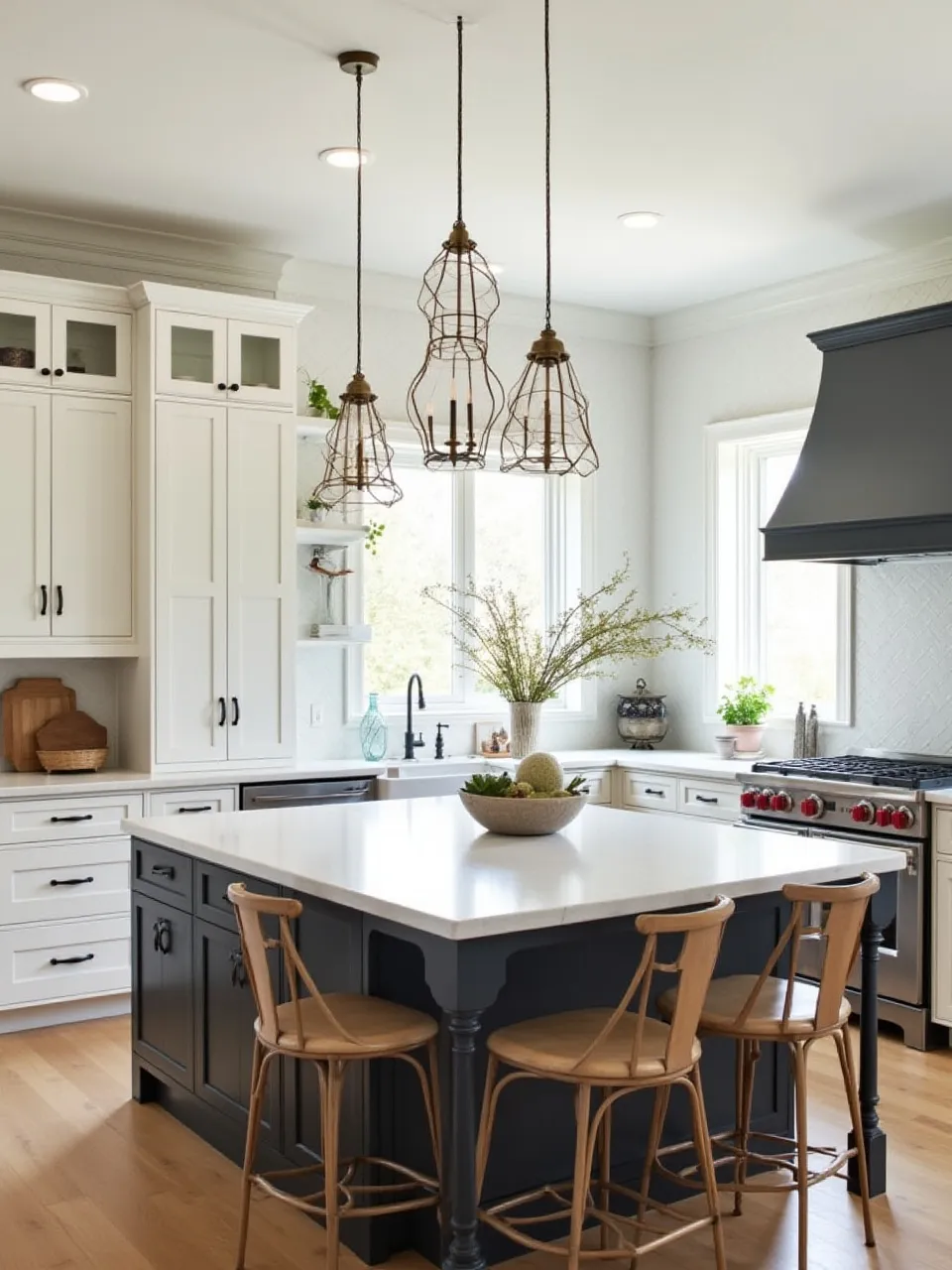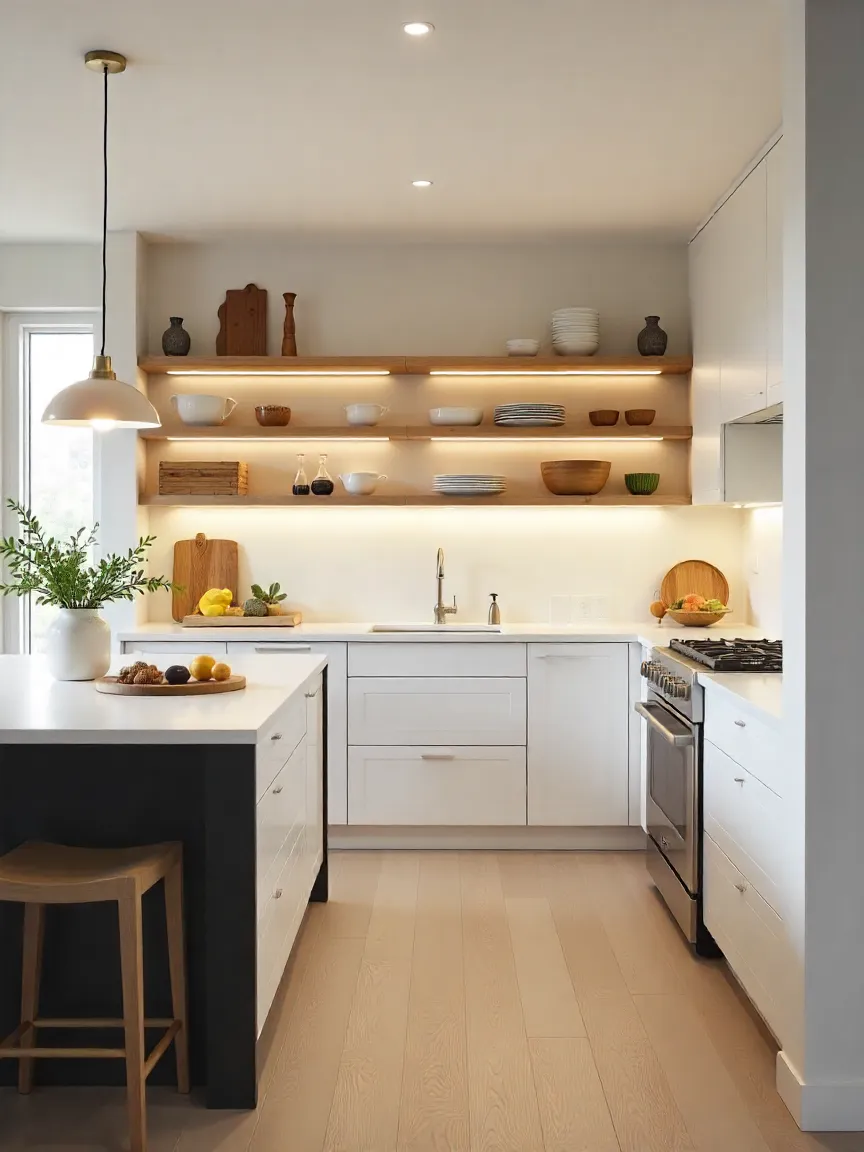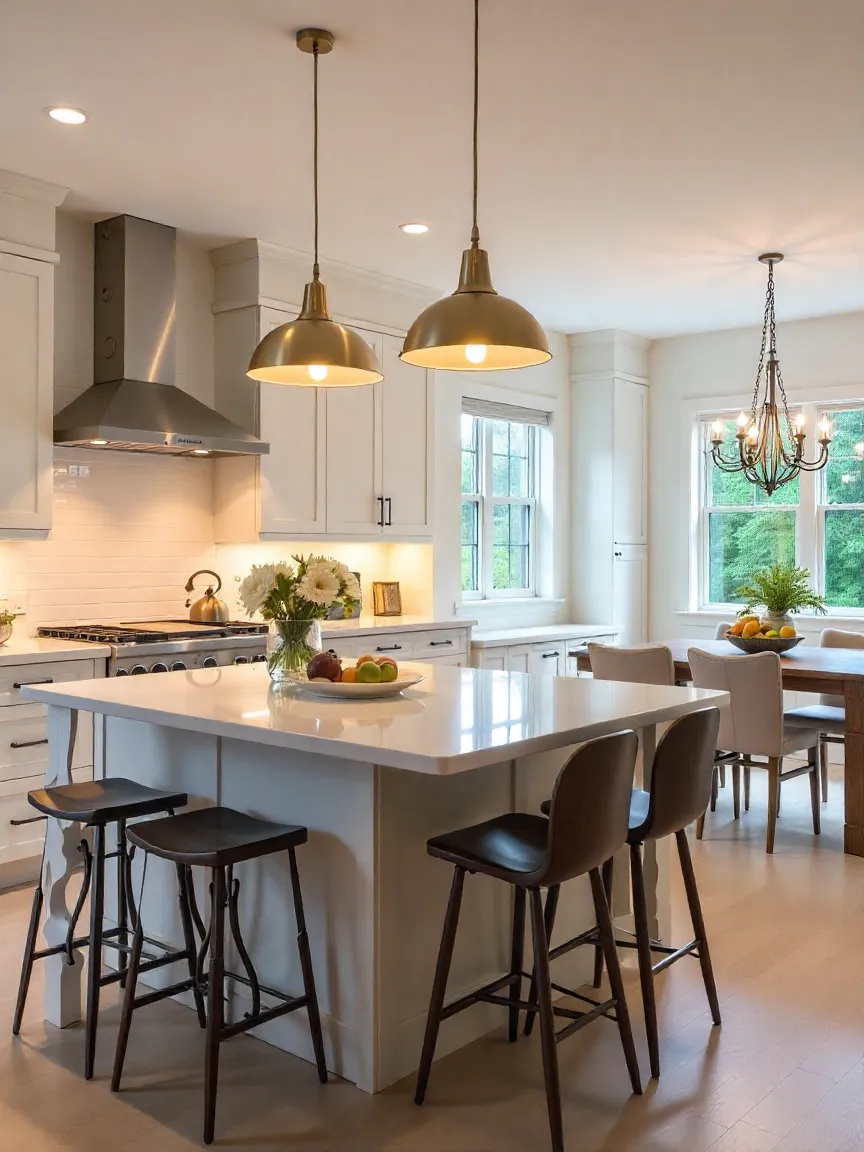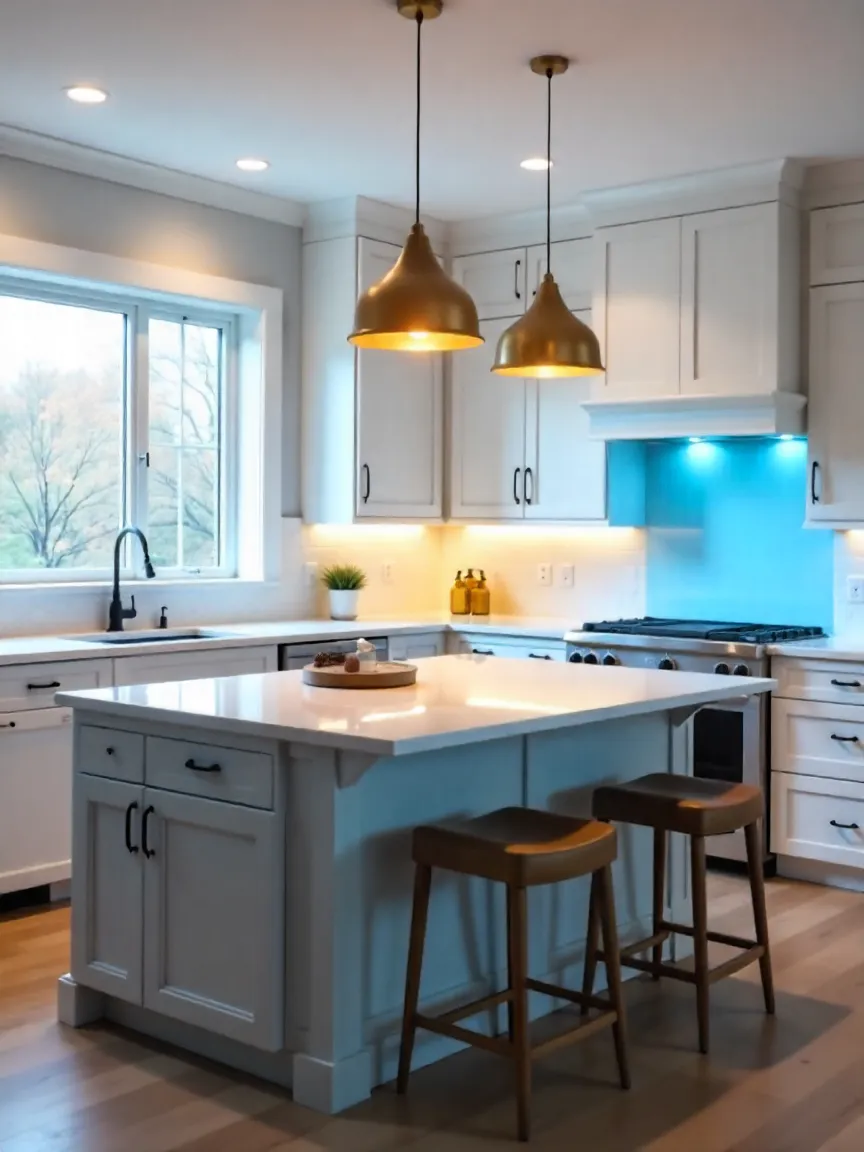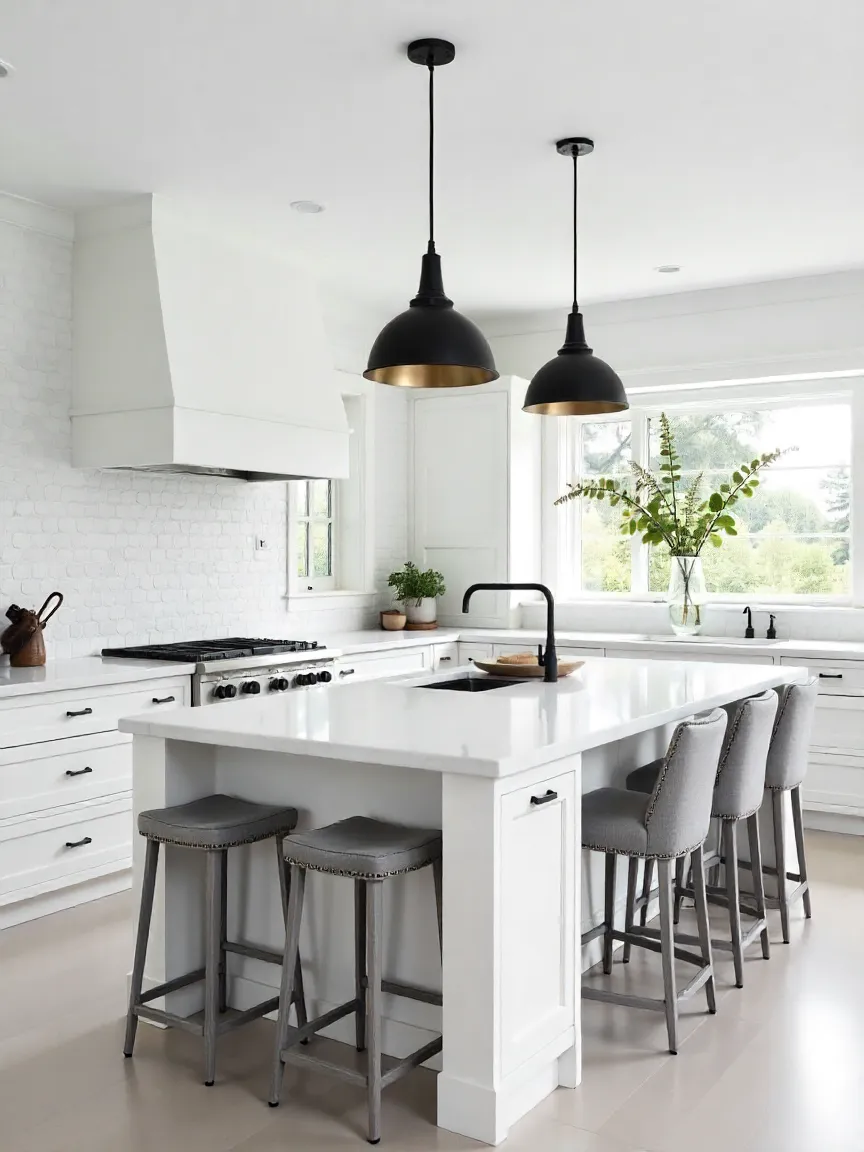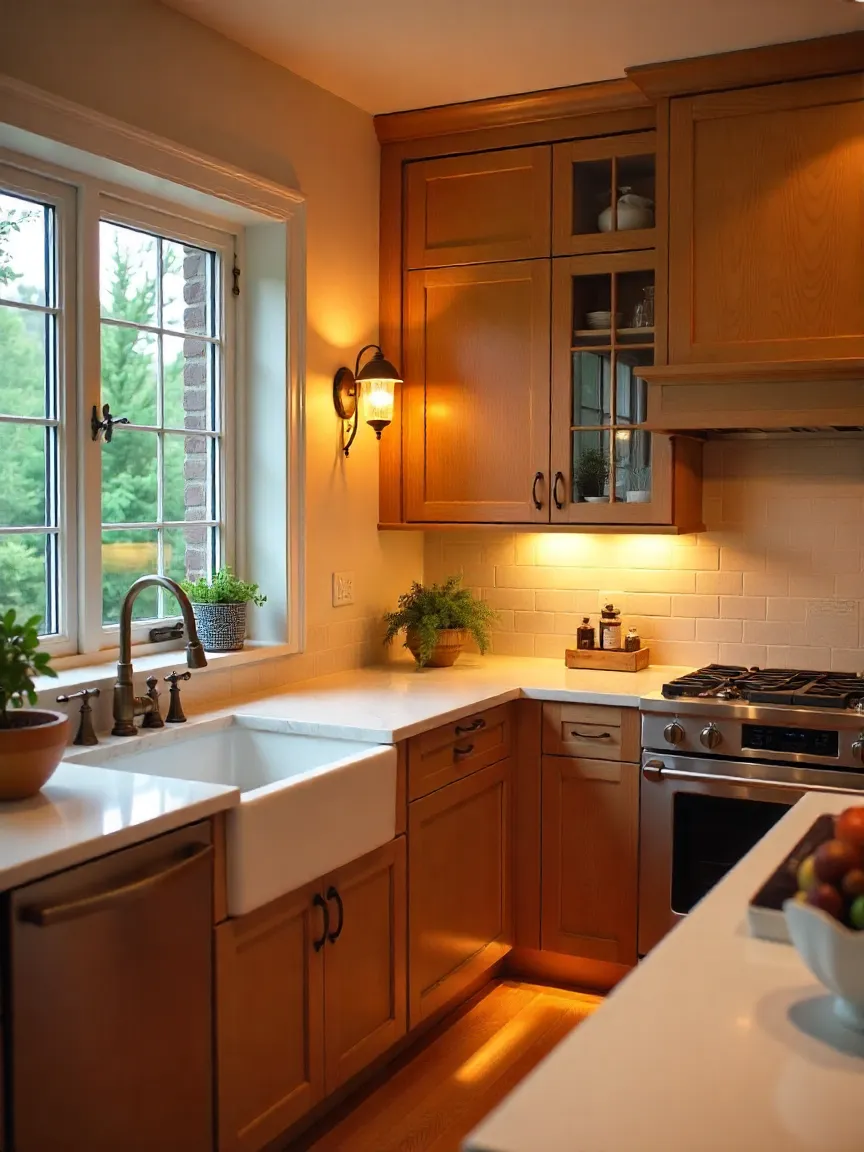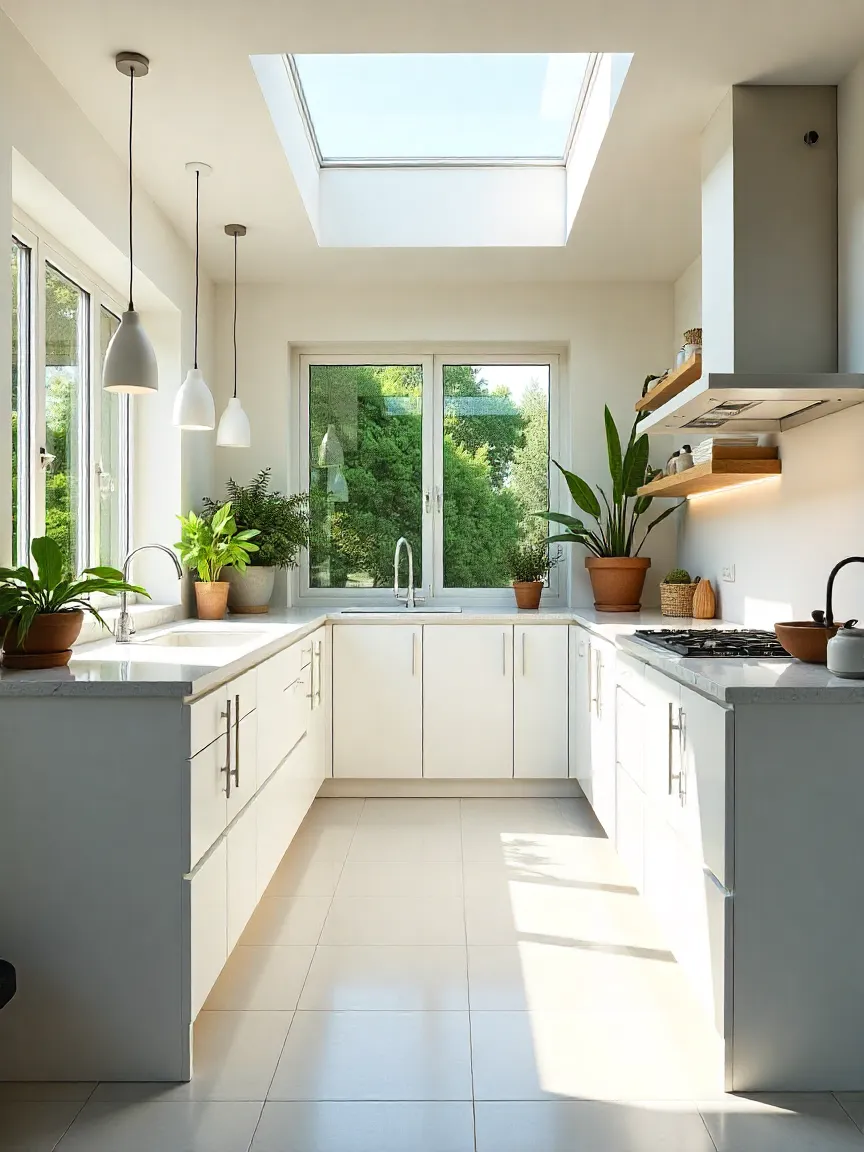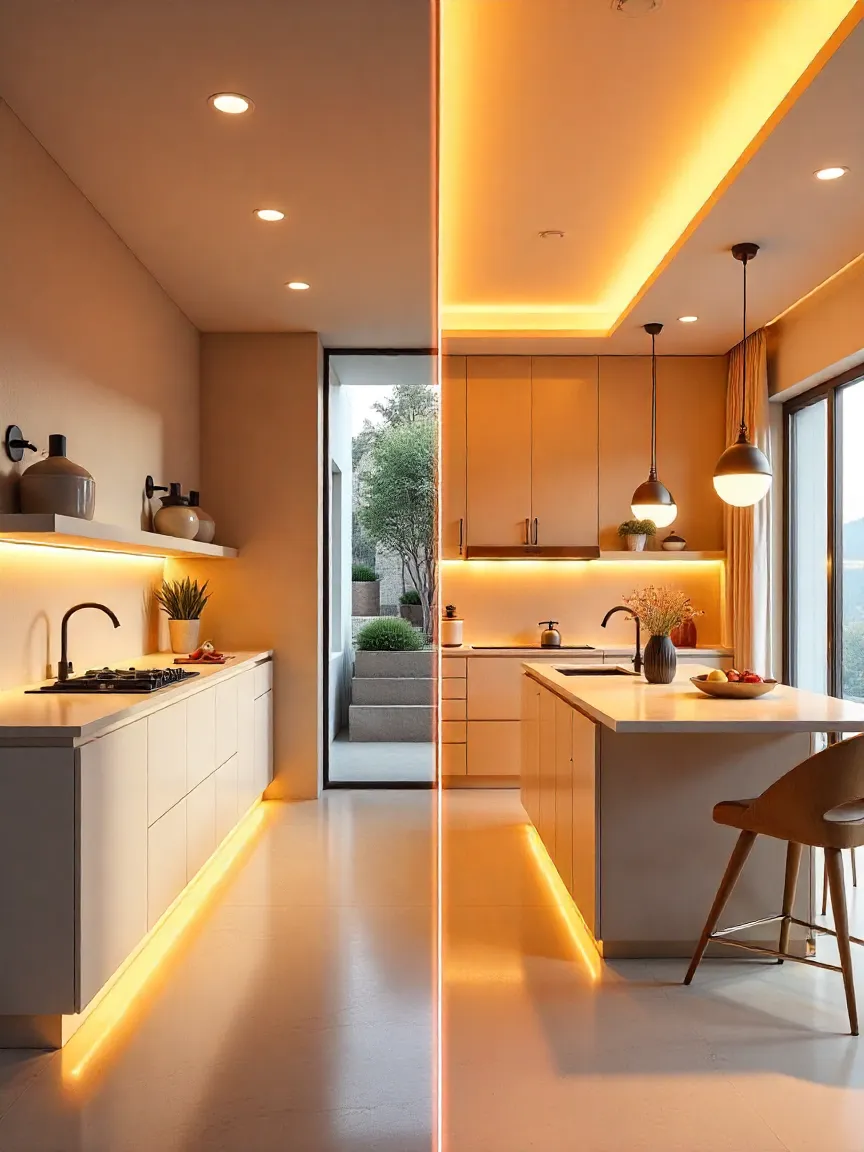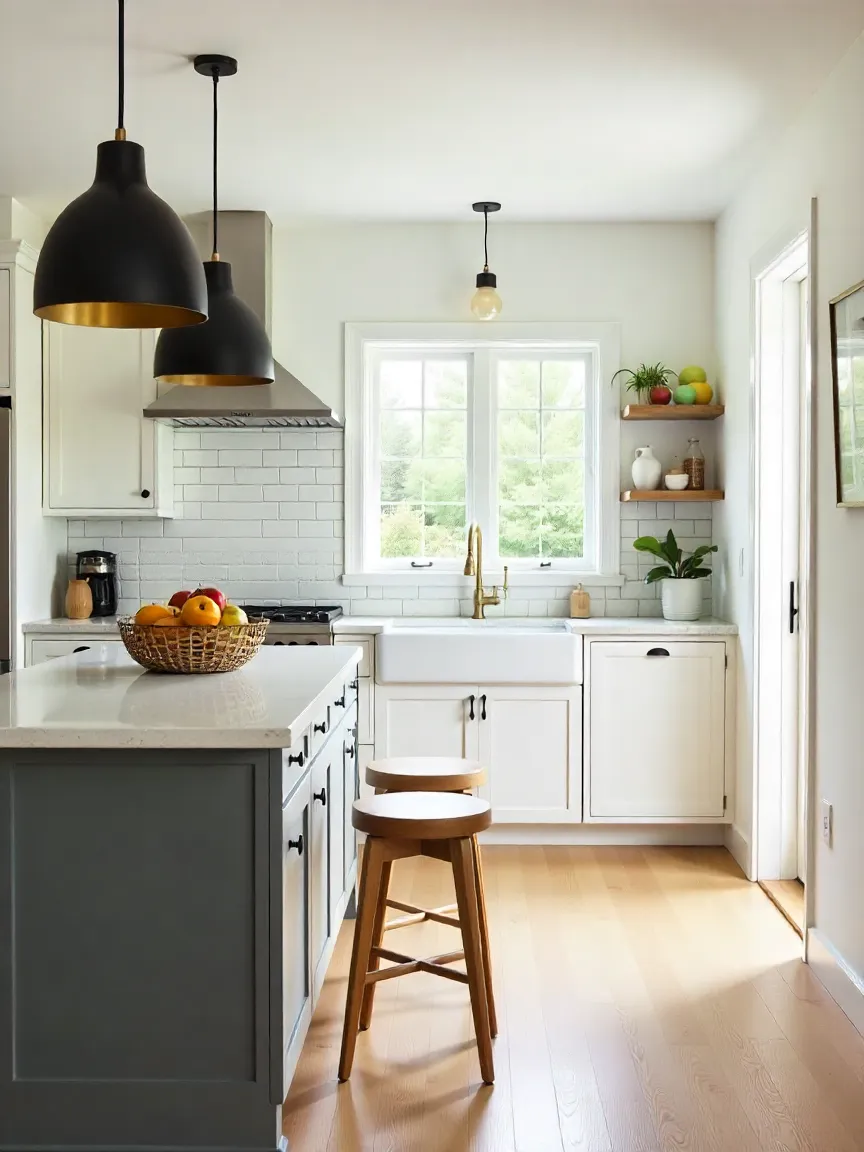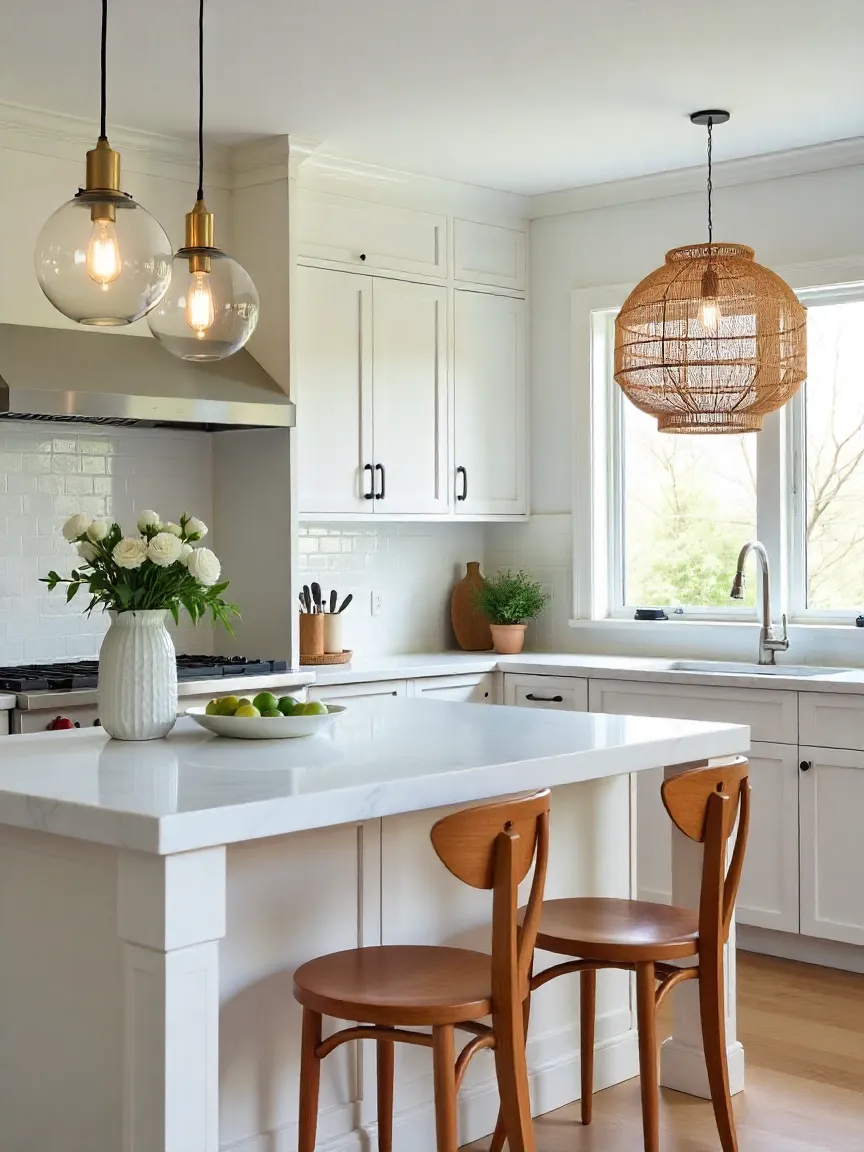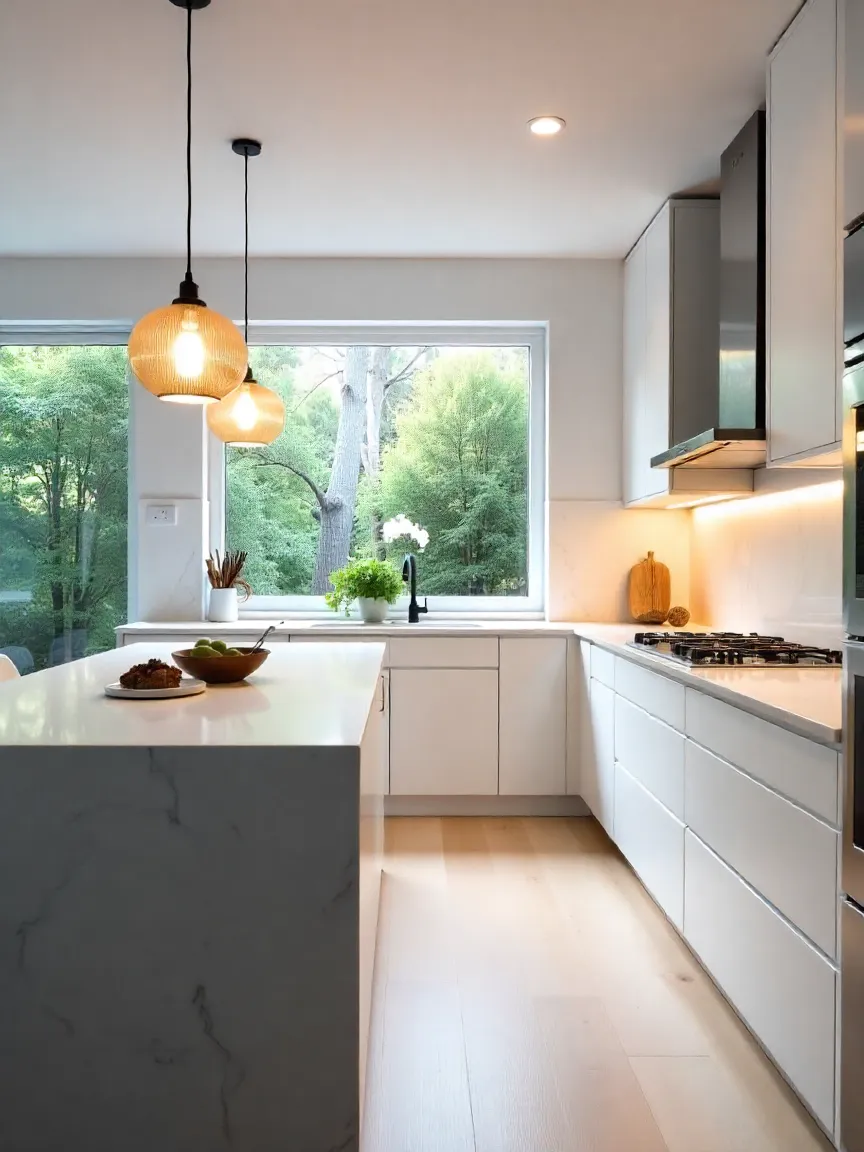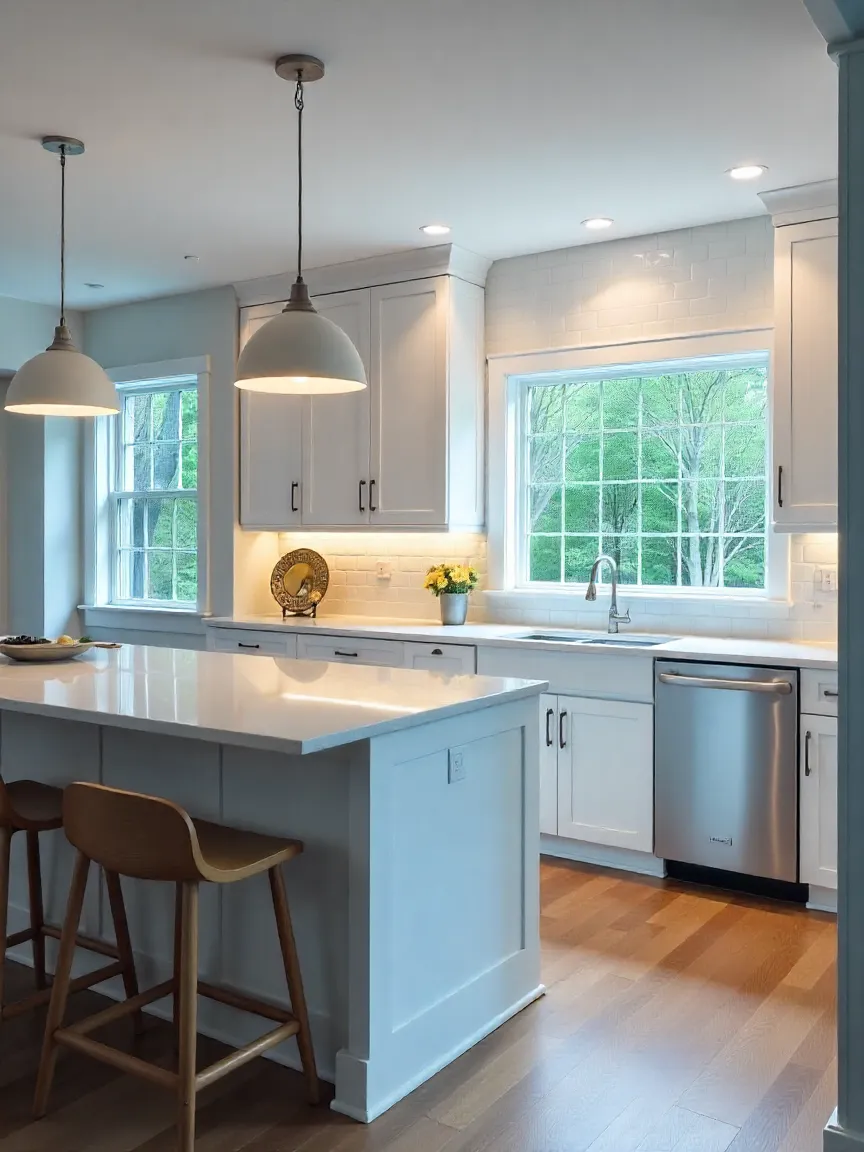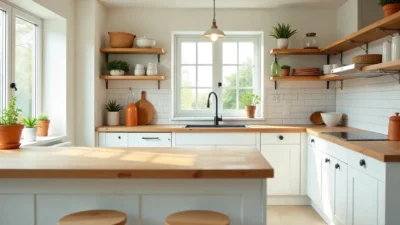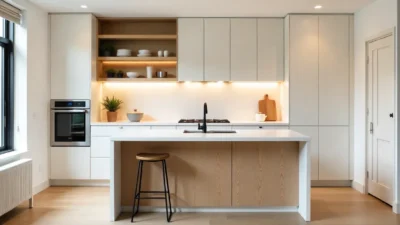Contents
- Understanding Kitchen Lighting Basics: The Foundation of Great Design 💡
- Designing with Light Fixtures: Elevate Your Kitchen Style and Functionality ✨
- Illuminating the Kitchen Island: Style Meets Functionality 💡✨
- Accent and Decorative Lighting Ideas to Add Charm and Ambiance ✨
- Task Lighting for Efficiency: Brighten Your Kitchen Workspaces 💡🔪
- Natural Light Integration: Brighten Your Kitchen the Eco-Friendly Way 🌞
- Lighting for Small and Large Kitchens: Scale, Balance & Design Tips 💡
- Innovative Lighting Styles: Transform Your Kitchen with Trendy Fixtures ✨
- Decorative Elements and Materials: Adding Style and Personality to Kitchen Lighting ✨
- Final Considerations: Getting Kitchen Lighting Just Right 💡
- Frequently Asked Questions About Kitchen Lighting 💡
Lighting is one of the most important design elements in any kitchen—it doesn’t just illuminate the space, it sets the mood and improves functionality. The right lighting can transform a dull, shadowy kitchen into a bright, inviting, and practical space where cooking, dining, and entertaining feel effortless.
Whether you’re planning a full renovation or just updating fixtures, smart kitchen lighting ideas can make all the difference. This guide will cover everything from lighting basics and fixture selection to task lighting, accent details, and natural light integration—helping you create a kitchen that’s as beautiful as it is functional.
✅ Why Kitchen Lighting Matters
Your kitchen isn’t just a place to cook—it’s often the heart of the home. That’s why good lighting serves multiple purposes:
- Functionality: Adequate light for chopping, cooking, and cleaning.
- Ambiance: A warm, welcoming glow for family and guests.
- Design Impact: Stylish fixtures that complement your decor.
✅ Before You Start: Know the Basics
Creating the perfect lighting plan begins with understanding a few key factors:
- Kitchen Size & Layout: A large open-plan kitchen needs a layered lighting approach, while smaller kitchens require strategic placement.
- Natural Light Availability: Consider how much daylight your space gets and where you need to supplement.
- Activity Zones: Cooking, prepping, and dining areas all require different levels of illumination.
Once you know these details, you can decide which lighting types—ambient, task, accent, and decorative—will work best for your kitchen.
Understanding Kitchen Lighting Basics: The Foundation of Great Design 💡
Choosing the perfect kitchen lighting can feel overwhelming—with so many options in fixtures, styles, and layouts, where do you start? The key is understanding the fundamental principles of kitchen lighting. Once you grasp the basics, designing a bright, functional, and stylish space becomes much easier.
✅ Why Lighting Matters in the Kitchen
The kitchen isn’t just a cooking area—it’s a multifunctional space for meal prep, family gatherings, and entertaining. Poor lighting can make tasks harder and affect the overall mood of the room. The right lighting design ensures:
- Efficiency: Proper illumination for chopping, cooking, and cleaning.
- Comfort: A warm and welcoming atmosphere for family and guests.
- Aesthetic Appeal: Stylish fixtures that elevate your kitchen’s look.
✅ The Three Layers of Kitchen Lighting
To create a balanced and effective lighting scheme, focus on three main layers:
- Ambient Lighting – Your primary light source that fills the room. Typically achieved with ceiling fixtures, recessed lights, or pendant lights.
- Task Lighting – Bright, focused light for work areas like countertops, islands, and sinks. Think under-cabinet lighting or track lights.
- Accent & Decorative Lighting – Adds style and highlights focal points like open shelves, artwork, or a statement backsplash.
✅ Key Factors to Consider
- Kitchen Size & Layout: Larger spaces require layered lighting, while smaller kitchens benefit from strategically placed fixtures.
- Natural Light: Assess daylight availability and plan for supplemental lighting in dim areas.
- Ceiling Height: Impacts fixture choice—pendants or chandeliers for high ceilings, flush mounts for low ceilings.
Bottom Line: Understanding these lighting fundamentals will help you create a kitchen that looks stunning and works beautifully for everyday life.
The Importance of Scale and Size in Kitchen Lighting
One of the biggest mistakes homeowners make when planning kitchen lighting is ignoring scale and proportion. Fixtures that are too small can make your kitchen feel dark and unbalanced, while oversized lighting can dominate the space and look awkward.
✅ How to Choose the Right Size
- General Rule for Islands & Tables: Select fixtures that are 12–18 inches smaller than the width of the island or dining table.
- Pendant Lighting Tip: For multiple pendants, leave at least 24–30 inches of space between each fixture for balance.
- Ceiling Height Matters: Higher ceilings allow for larger statement lights, while low ceilings call for slimmer, more compact designs.
Choosing the Right Style for Your Kitchen
Your lighting should complement your overall kitchen design. Whether your space leans modern, farmhouse, or transitional, there’s a fixture to match.
Popular Styles Include:
- Pendant Lights: Perfect for islands or breakfast bars; available in glass, metal, and woven textures.
- Chandeliers: Add drama and elegance to a large kitchen or dining area.
- Track Lighting: A versatile, modern solution for brightening multiple work zones.
Pro Tip: Consider the finish and color tone of your cabinets, hardware, and countertops for a cohesive look. For example, matte black pendants pair beautifully with white cabinetry for a sleek contrast, while brass fixtures add warmth to neutral spaces.
Functional Layers of Kitchen Lighting
Great kitchen lighting isn’t just about style—it’s about functionality. Layering your lighting creates depth and ensures every part of your kitchen is well-lit.
- Ambient Lighting – The primary light source that illuminates the whole room (e.g., recessed lights, flush mounts).
- Task Lighting – Focused light for work areas like countertops, sinks, and stoves (e.g., under-cabinet LEDs, pendant lights).
- Mood or Accent Lighting – Adds warmth and highlights focal points like open shelving or decorative backsplashes (e.g., strip lights, sconces).
Why It Matters: Combining these layers creates a functional, stylish kitchen that looks good and works even better.
✅ Bottom Line: When planning your kitchen lighting, consider scale, style, and layered functionality. These factors work together to enhance your kitchen’s beauty, comfort, and practicality.
Designing with Light Fixtures: Elevate Your Kitchen Style and Functionality ✨
Light fixtures are more than just practical elements in your kitchen—they’re key design features that can completely transform the look and feel of the space. The right lighting fixtures enhance functionality, define your kitchen’s style, and create ambiance for everything from cooking to entertaining.
✅ Why Light Fixtures Matter
- Functionality: Proper lighting ensures safe and efficient food prep.
- Aesthetic Appeal: Fixtures can serve as statement pieces or blend seamlessly for a minimalist look.
- Mood Setting: The style, size, and placement of fixtures all influence the kitchen’s atmosphere.
Top Ways to Design with Kitchen Light Fixtures
1. Make a Statement with Pendant Lighting
Pendant lights are perfect for islands or dining spaces. They come in glass, metal, or natural textures for different aesthetics:
- Modern Minimalist: Sleek metal pendants in matte black or brushed steel.
- Farmhouse Chic: Woven or rustic wood pendants for a cozy vibe.
- Industrial Style: Exposed bulbs and metallic finishes.
Tip: Use odd numbers (like three pendants) for a balanced look.
2. Layer with Recessed and Track Lighting
Combine recessed ceiling lights with track lights to brighten every corner.
- Recessed Lighting: Ideal for even, general illumination.
- Track Lighting: Flexible and perfect for highlighting specific work zones or art pieces.
3. Add Drama with Chandeliers or Oversized Fixtures
Want a bold focal point? A statement chandelier above the island or dining area can add luxury and personality. Choose a design that matches your kitchen’s overall theme.
4. Under-Cabinet Lighting for Practicality
One of the most effective ways to improve task lighting is with under-cabinet LED strips or puck lights. They provide shadow-free illumination for chopping and cooking.
✅ Pro Design Tip: Coordinate the finish of your light fixtures with hardware (like cabinet handles or faucets) for a cohesive, polished look.
Statement Lighting as a Focal Point: Make Your Kitchen Shine ✨
If you want your kitchen to feel luxurious and visually striking, statement lighting is the way to go. A bold light fixture—whether it’s a glamorous chandelier, a sculptural pendant, or an oversized modern fixture—can instantly transform your kitchen from ordinary to extraordinary.
✅ How to Choose the Perfect Statement Piece
- Consider Scale:
- A large chandelier looks stunning in a spacious kitchen but can overwhelm a smaller one.
- For compact kitchens, opt for sleek pendants or cluster lights for drama without bulk.
- Match the Style:
- Modern kitchens pair well with geometric or metallic fixtures.
- Farmhouse kitchens look great with rustic wood or lantern-style lights.
Mix and Match for a Unique Look
Layering lighting adds depth and dimension to your kitchen design. Instead of sticking to one type of fixture, combine styles for a curated and personalized aesthetic.
- Example Combos:
- Pendant lights + wall sconces for practical elegance.
- A statement chandelier over the island with subtle recessed lights for balance.
- Brass and matte black finishes for a trendy mixed-metal look.
Pro Tip: Keep at least one common design element (like finish or shape) to ensure cohesion.
The Role of Pendant Lighting
Pendant lights are a kitchen favorite for good reason—they’re versatile, stylish, and functional.
- Best Uses:
- Over kitchen islands for task lighting.
- Over dining tables for ambiance.
- Style Options:
- Industrial: Exposed bulbs, metal finishes.
- Modern Minimalist: Sleek glass or geometric shapes.
- Farmhouse: Woven baskets, wood accents.
Size & Placement Tips:
- For islands, hang pendants 28–34 inches above the countertop.
- Use odd numbers (3 or 5) for visual balance.
✅ Bottom Line: Whether you choose a dramatic chandelier, layered lighting, or classic pendants, the right light fixtures bring style, warmth, and functionality to your kitchen design.
Illuminating the Kitchen Island: Style Meets Functionality 💡✨
The kitchen island is often the centerpiece of modern kitchens—a spot for meal prep, casual dining, and social gatherings. That’s why choosing the right lighting is crucial. Good island lighting enhances functionality, adds visual drama, and ties the whole design together.
✅ Why Lighting the Island Matters
- Task Lighting: Provides clear, focused illumination for chopping, cooking, and serving.
- Design Statement: Pendants or chandeliers create a striking focal point in open layouts.
- Ambiance: Adjustable lighting helps transition from cooking mode to entertaining mode.
How to Choose the Perfect Pendant Size & Placement
1. Get the Scale Right
- Width Rule: Each pendant should measure 12–18 inches smaller than the island width.
- Number of Pendants:
- Small islands → 2 pendants
- Large islands → 3 or more pendants
- Spacing: Leave 24–30 inches between pendants for balance.
2. Height Matters
- Hang pendants 28–34 inches above the countertop for optimal lighting without obstructing views.
Blend Style with Functionality
Your island lighting should complement your kitchen’s overall aesthetic:
- Modern Kitchens: Sleek glass pendants, metallic finishes, or geometric shapes.
- Contemporary Spaces: Cluster pendants for an artistic vibe.
- Farmhouse & Rustic: Warm tones, wood, or woven textures.
Pro Tip: Install dimmers to adjust brightness for different tasks—bright for cooking, soft for dining.
✅ Bottom Line: The right kitchen island lighting combines form and function, creating a space that’s both practical and visually stunning.
Choosing the Perfect Pendant Size for Your Kitchen Island
Getting the size of your pendant lights right is key to balanced design and effective illumination. A fixture that’s too small can look lost, while one that’s too large can dominate the space and throw off the proportions.
✅ Pendant Sizing Guidelines
- Width Rule: Each pendant should measure ⅓ to ⅔ the width of your kitchen island for proper scale.
- Number of Pendants:
- Small island → 2 pendants
- Large island → 3 or more pendants evenly spaced.
- Ceiling Height Considerations:
- High ceilings: Use larger pendants or group smaller pendants together for visual impact.
- Low ceilings: Opt for smaller pendants or sleek flush-mount fixtures to avoid clutter.
Integrating Functionality and Style
Lighting should be both practical and beautiful. The right pendant lights enhance kitchen aesthetics while delivering the brightness needed for tasks like chopping and plating.
- Style Ideas:
- Bold & Modern: Sculptural shapes, metallic finishes, or smoked glass for a contemporary edge.
- Minimalist: Simple, clean lines for a sleek look in modern kitchens.
- Rustic or Farmhouse: Warm tones and natural textures like wood or wicker for a cozy vibe.
- Functional Features:
- Dimmable Switches: Adjust brightness for different activities—bright for cooking, soft for dining.
- Adjustable Heights: Perfect for customizing pendant positioning over an island or dining table.
✅ Bottom Line: The right pendant size and design will balance functionality with style, making your kitchen island both a statement piece and a highly functional workspace.
Accent and Decorative Lighting Ideas to Add Charm and Ambiance ✨
Kitchen lighting isn’t just about bright task lights—it’s also about creating atmosphere and adding character. Accent and decorative lighting can bring warmth, style, and personality to your kitchen, making it feel inviting for family and guests alike.
✅ Adding Charm with Sconces and Chandeliers
- Wall Sconces:
Install sconces on either side of a window, above the sink, or along open shelving for a warm, layered glow. They’re perfect for breaking up blank walls and adding visual interest. - Chandeliers:
A chandelier above the kitchen island or dining table can serve as a stunning focal point. From elegant crystal designs to modern geometric shapes, chandeliers can match any design style.
Style Tips:
- Traditional Kitchens: Crystal chandeliers, antique brass sconces.
- Modern Spaces: Sleek sconces, matte black or metallic geometric chandeliers.
- Farmhouse Style: Rustic wood accents and lantern-inspired fixtures.
✅ Creating Ambiance with Dimmers and Soft Lighting
- Dimmer Switches:
A simple upgrade that transforms your kitchen’s mood instantly. Go from bright task lighting for meal prep to a soft, cozy glow for entertaining at the touch of a button. - Under-Cabinet Lighting:
Add LED strip lights under cabinets for a subtle, elegant effect that highlights your countertops and backsplash. - Candles & Decorative Fixtures:
For dinner parties or romantic evenings, candles and soft accent lights create a warm, intimate atmosphere.
✅ Bottom Line: Accent and decorative lighting isn’t just practical—it’s a design tool that can elevate your kitchen’s style while making the space feel inviting and cozy.
Task Lighting for Efficiency: Brighten Your Kitchen Workspaces 💡🔪
When it comes to kitchen design, task lighting is a non-negotiable element. Unlike ambient lighting, which brightens the entire room, task lighting focuses on specific work zones—like countertops, sinks, and cooking areas—where precision and safety matter most.
Without proper task lighting, prepping vegetables, reading recipes, or cleaning up becomes difficult and potentially hazardous. Here’s how to ensure your kitchen is as functional as it is stylish.
✅ Why Task Lighting Matters
- Improves visibility for food prep, cooking, and cleaning.
- Reduces shadows that overhead lights can create on work surfaces.
- Adds depth and dimension when layered with ambient and accent lighting.
Best Task Lighting Solutions for Kitchens
1. Under-Cabinet Lighting Solutions
Under-cabinet lighting is one of the most effective and popular choices for brightening countertops. It directs light exactly where you need it—your work surface.
Types of Under-Cabinet Lighting:
- LED Strip Lights:
- Slim, energy-efficient, and easy to install.
- Provide even illumination across the entire countertop.
- Puck Lights:
- Small, round fixtures ideal for spot lighting.
- Great for highlighting specific zones like the sink or stove.
- Linear Lights:
- Sleek, modern option for continuous lighting under cabinets.
- Perfect for a minimalist design aesthetic.
2. Brightening Work Areas with Downlights
Downlights deliver focused, powerful illumination—ideal for key kitchen zones.
Options for Downlighting:
- Recessed Downlights:
- Blend seamlessly into the ceiling for a clean, modern look.
- Best for general task lighting above prep stations and islands.
- Track Lighting:
- Flexible design that lets you angle light exactly where you need it.
- Ideal for open-plan kitchens or kitchens with uneven layouts.
- Pendant Lights:
- Combine function with style—especially over islands or dining areas.
- Great for creating a statement focal point while adding task lighting.
✅ Pro Tip: Install dimmers on task lighting for versatility—bright for cooking, softer for entertaining.
Bottom Line:
Task lighting isn’t just a design detail—it’s essential for a safe, efficient, and enjoyable kitchen experience. By combining under-cabinet lighting with downlights or pendants, you can achieve the perfect balance of functionality and style.
Natural Light Integration: Brighten Your Kitchen the Eco-Friendly Way 🌞
Natural light can completely transform the look and feel of your kitchen. It’s not just about aesthetics—maximizing natural light can reduce energy costs and create a warm, welcoming atmosphere that artificial lighting alone can’t replicate. Here’s how to make the most of daylight in your kitchen design.
✅ Why Natural Light Matters
- Energy Efficiency: Less reliance on artificial lighting saves electricity.
- Improved Mood: Bright, sunlit spaces feel more uplifting and spacious.
- Visual Appeal: Enhances colors, textures, and overall design.
Maximizing Daylight in Kitchen Design
1. Install Larger Windows or Skylights
- Large windows or floor-to-ceiling glass panels flood the space with natural light.
- Skylights or solar tubes are perfect for kitchens without exterior walls.
- For privacy, consider frosted or tinted glass or install sheer curtains for a soft glow.
2. Use Reflective, Light-Colored Finishes
- Opt for white or light-toned cabinets, countertops, and backsplashes to bounce light around the room.
- Glossy finishes on cabinetry or tiles enhance reflectivity.
- Light-colored flooring helps amplify brightness.
3. Keep Windows Uncluttered
- Avoid heavy curtains or dark blinds; instead, use sheer fabrics or no coverings for maximum daylight.
Blending Artificial and Natural Light
Natural light isn’t always available—cloudy days and evenings happen! That’s where a layered artificial lighting plan comes in.
- Combine Different Types of Lighting:
- Ambient lighting for overall brightness.
- Task lighting for work areas.
- Accent lighting for depth and style.
- Install Dimmer Switches:
- Adjust brightness to complement daylight levels throughout the day.
- Bright mornings, soft evenings—total control over ambiance.
✅ Pro Tip: Position reflective surfaces like mirrors or glass tiles near windows to maximize natural light flow.
Bottom Line:
Integrating natural light into your kitchen design creates a space that’s eco-friendly, visually stunning, and mood-enhancing. Combine it with smart artificial lighting for the perfect balance of function and ambiance—day or night.
Lighting for Small and Large Kitchens: Scale, Balance & Design Tips 💡
When designing a kitchen, size matters—and that includes your lighting strategy. The right lighting can maximize space in a small kitchen or create balance in a large one, ensuring your kitchen is both functional and visually appealing.
✅ Why Kitchen Size Affects Lighting Choices
- Small Kitchens: Overly large fixtures can crowd the space, making it feel cramped.
- Large Kitchens: Small lights may leave dark spots, reducing functionality and comfort.
Adjusting Lighting Scale to Kitchen Size
- General Rule: Use one main light fixture for every 50 square feet of kitchen space for even illumination.
- Small Kitchens:
- Choose compact, low-profile fixtures like flush mounts or mini-pendants.
- Consider light-reflective finishes to enhance brightness.
- Large Kitchens:
- Opt for larger, statement fixtures or multiple pendants over the island.
- Add layered lighting (ambient, task, and accent) to avoid dark corners.
Strategies for High and Low Ceilings
- High Ceilings:
- Use pendant lights or chandeliers to create a focal point and visually lower the ceiling.
- Consider track lighting for flexibility and coverage.
- Low Ceilings:
- Choose flush-mount or recessed lighting to maximize headroom.
- Incorporate under-cabinet lights to brighten work areas without crowding the space.
Pro Tip: Use dimmers in both small and large kitchens for better control over light levels and ambiance.
Bottom Line:
The right lighting plan balances scale, proportion, and ceiling height to create a kitchen that feels bright, functional, and stylish—no matter its size.
Innovative Lighting Styles: Transform Your Kitchen with Trendy Fixtures ✨
Lighting is more than just a functional necessity—it’s a design statement that can completely change the mood and style of your kitchen. Whether you love sleek modern vibes, rustic charm, or retro flair, the right lighting style can elevate your entire space. Here are top innovative lighting ideas to inspire your kitchen makeover:
✅ Modern and Minimalist Lighting
If your kitchen design leans toward clean lines and contemporary elegance, modern lighting styles are your perfect match.
- Key Features: Simple shapes, neutral tones, and understated elegance.
- Ideas to Try:
- Geometric Pendant Lights: Slim, angular designs in matte black or brushed nickel.
- Linear Chandeliers: Perfect for islands or long dining tables.
- LED Strip Lighting: Install under cabinets, inside drawers, or along ceiling coves for a soft, futuristic glow.
✅ Rustic and Farmhouse Lighting
For a warm, inviting kitchen with timeless appeal, rustic and farmhouse trends are a go-to choice.
- Key Features: Natural textures, warm metals, and a cozy vibe.
- Ideas to Try:
- Lantern-Style Pendants: Ideal for a country-inspired kitchen island.
- Exposed Bulb Chandeliers: Adds a touch of industrial charm.
- Mason Jar Fixtures or Wire Basket Lights: Perfect for farmhouse aesthetics.
✅ Retro and Mid-Century Modern Lighting
Love vintage charm with a modern twist? Retro lighting styles deliver personality and playfulness.
- Key Features: Bold colors, metallic accents, and statement silhouettes.
- Ideas to Try:
- Sputnik Chandeliers: A mid-century icon that adds drama and dimension.
- Globe Pendant Lights: Sleek and elegant, ideal for retro-modern kitchens.
- Colored Glass Shades: Bring in fun pops of color for a nostalgic yet stylish look.
Why Style Matters
Your lighting isn’t just about illumination—it’s an opportunity to express your personality. By selecting a style that complements your kitchen’s design theme, you create a cohesive, visually striking space that feels uniquely yours.
✅ Bottom Line: From modern minimalism to rustic charm to retro glam, innovative lighting can take your kitchen design to the next level—making it stylish, functional, and unforgettable.
Decorative Elements and Materials: Adding Style and Personality to Kitchen Lighting ✨
Lighting isn’t just functional—it’s an essential design feature that can define the style and character of your kitchen. By incorporating decorative elements and interesting materials, you can transform standard lighting into a stunning focal point that elevates the entire space.
✅ Metallic and Glass Accents for an Elegant Look
For a sophisticated and timeless kitchen, metallic finishes and glass accents are a perfect match.
- Metallic Finishes:
- Brass & Gold: Add warmth and luxury to traditional or transitional kitchens.
- Chrome & Nickel: Ideal for sleek, modern designs.
- Clear or Frosted Glass Shades:
- Let natural and artificial light shine through for a bright, airy feel.
- Work beautifully with pendants, chandeliers, or sconces for both task and decorative lighting.
Pro Tip: Pair metallic fixtures with matching hardware and faucet finishes for a cohesive, designer look.
✅ Rattan and Whimsical Designs for Texture and Fun
Want a kitchen that feels warm, natural, and unique? Rattan and playful designs are trending in modern homes.
- Rattan Lighting:
- Adds texture and organic warmth—perfect for bohemian, coastal, or farmhouse kitchens.
- Looks stunning in oversized pendants over an island or breakfast nook.
- Whimsical Fixtures:
- Fixtures with fun shapes, bold colors, or artistic forms add personality.
- Think animal-inspired designs, colorful shades, or sculptural pendants for a statement look.
Why Decorative Details Matter
Choosing the right materials and decorative accents can:
- Enhance your design theme (modern, rustic, eclectic).
- Add visual interest and personality to an otherwise simple kitchen.
- Create a cohesive look when paired with cabinetry, hardware, and furniture.
✅ Bottom Line: Whether you opt for luxurious metallics, sleek glass, natural rattan, or whimsical designs, decorative elements are the finishing touch that takes your kitchen lighting from practical to picture-perfect.
Final Considerations: Getting Kitchen Lighting Just Right 💡
The right kitchen lighting isn’t just about aesthetics—it impacts functionality, energy efficiency, and overall ambiance. Before finalizing your lighting plan, keep these critical factors in mind:
✅ The Impact of Color and Light Quality
- Color Temperature Matters:
- Warm Light (2700K–3000K): Creates a cozy, welcoming atmosphere, ideal for traditional or rustic kitchens.
- Cool Light (3500K–5000K): Offers a crisp, modern look, perfect for contemporary spaces.
- Light Quality:
- Opt for high-quality LED bulbs for bright, natural-looking illumination that’s easy on the eyes.
- LEDs consume less energy, last longer, and deliver consistent brightness—perfect for task-heavy areas like countertops and cooking zones.
✅ Energy Efficiency and Sustainable Choices
- LED Advantage:
- Consumes up to 80% less energy than traditional bulbs.
- Longer lifespan means fewer replacements and less waste.
- Look for ENERGY STAR Certification:
- Ensures top-tier efficiency and performance.
- Maximize Natural Light:
- Install large windows, skylights, or sun tunnels to brighten your kitchen naturally and reduce daytime energy use.
- Pair natural light with reflective surfaces (like glossy cabinets or glass tiles) for an even brighter effect.
✅ Pro Tip: Combine dimmable LED fixtures with layered lighting design (ambient, task, and accent) for full control over brightness and mood.
Bottom Line:
A well-thought-out lighting plan can transform your kitchen into a functional, stylish, and energy-efficient space. By considering color temperature, light quality, sustainability, and smart design choices, you’ll create a kitchen that looks beautiful and works beautifully—day or night.
Whether you’re after a statement chandelier, sleek pendant lights, or innovative under-cabinet LEDs, today’s options make it easy to strike the perfect balance of style and practicality.
Frequently Asked Questions About Kitchen Lighting 💡
✅ 1. What are some innovative small kitchen lighting solutions?
Small kitchens require smart lighting that saves space without sacrificing style. Consider:
- Under-Cabinet Lighting: Adds bright, focused light for prep areas without cluttering countertops.
- Track Lighting: Flexible and space-saving; allows you to direct light where it’s needed most.
- Mini Pendants or Chandeliers: Provide elegance without overwhelming the room.
✅ 2. How can I choose the best ceiling lighting for my kitchen?
- For Large Kitchens: Use multiple fixtures or one oversized chandelier for balanced illumination.
- For Small Kitchens: Opt for compact flush-mount or semi-flush fixtures to save space.
- Always choose a style that complements your overall design—modern, rustic, or transitional.
✅ 3. What are the latest trends in modern kitchen lighting design?
- Natural Materials: Fixtures made from wood, rattan, or stone for a warm, organic look.
- Smart Lighting: Voice control, dimmable LEDs, and app-based systems for convenience and energy savings.
- Mixed Metals: Brass and matte black combos for a contemporary vibe.
✅ 4. Could you suggest some ideas for lighting over the kitchen sink?
- Pendant Lights: Stylish and functional for focused task lighting.
- Small Track Systems: Adjustable heads to direct light exactly where you need it.
- Recessed Lighting: A minimalist option for clean, even illumination.
✅ 5. What are the key considerations for proper kitchen illumination?
- Layered Lighting: Combine ambient, task, and accent lights for full coverage.
- Color Temperature: Warm light for a cozy atmosphere, cool light for a modern feel.
- Dimmers: Control brightness to switch between cooking and entertaining modes.
✅ 6. Where can I find inspiration for unique kitchen lighting arrangements?
- Design Magazines & Blogs: Great for curated, professional ideas.
- Pinterest & Instagram: Endless visual inspiration and trending designs.
- Lighting Designers: For a custom, perfectly balanced lighting plan tailored to your space.
✅ Bottom Line: Whether you have a compact urban kitchen or a spacious open-concept layout, the right lighting design blends style, functionality, and innovation—and these FAQs give you the perfect starting point.

